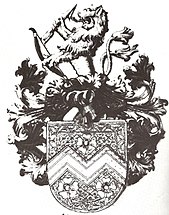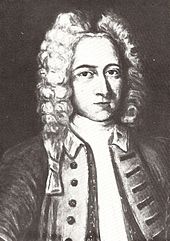Mauve (family)
Mauve is the name of a patrician and merchant family from the Baltic Sea coast.
history
The family was first mentioned in a document in the 13th and 14th centuries in several cities on the Baltic Sea coast (including Wismar , Rostock and Stargard in Pomerania ). A connection to the Mauves living in France is suspected, but has not yet been proven. The direct line of the Mauves begins with the councilor Peter Mauve (1485), who lives in Szczecin .
The Mauves branch living in Stargard called themselves Movius in the course of time. That it is the same family is clearly evident from the fact that members of the Movius family from Stargard called themselves Mauve again when they moved to Stettin (e.g. Peter Mauve 1618).
From the 15th to the 18th century, the Mauves belonged to the council of the two Hanseatic cities of Stargard and Stettin for ten generations as councilors (senators), treasurers and mayors. They include u. a. Jacob Mauve (1507 councilor in Stargard), Tewes Mauve (1520 treasurer of Stargard) Bartholomäus Mauve (1687 councilor in Stettin) and Kaspar Movius (1669–1747), mayor of Stargard, who founded the Movius Hospital in Königstrasse in Stargard. The Mauves were wealthy merchants - especially wine merchants - and some owned several estates in Pomerania and on Rügen .
Christian Mauve (1718–1781) ended the Mauve era as a wine merchant in Szczecin. His brothers Johann Bogislaw (1723–1789) and Daniel Friedrich (1725–1778) emigrated to India and Indonesia, respectively, Mattheus (* 1716) went to Torgau and Carl Heinrich (1720–1786) to Lingen , who thus formed the Westphalian line of Mauves reasoned.
Carl Heinrich Mauve had studied law in Halle and was dated April 15, 1750 by King Friedrich Wilhelm II . Secretary to the War and Domain Council in Lingen and Tecklenburg. His marriage to Christine Regina Balcke, a descendant of the Saxon Chancellor Gregor Pontanus , had two children. His son Carl-Philipp (1754-1821) studied law like his father and was appointed his father's successor in 1787. From 1806 to 1813, during the French occupation, he was sub-prefect in the Emsdepartement Lingen. Finally, in 1816, he became district administrator of the newly founded district of Tecklenburg .
Personalities
The descendants of Carl-Philipp Mauve include the following personalities:
- Anton Mauve (1838–1888) well-known Dutch landscape painter who taught Vincent van Gogh to paint with oil. Member of the Hague School .
- Carl Mauve (1829–1886) mine director; General representative of the Tiele-Winckler mines and smelting works in Katowice ; Founder and chairman of the Upper Silesian Miners' Association
- Eberhard Mauve (1885–1964) industrialist in Blosdorf; Princely Liechtenstein mountain ridge; Racing rider; Horse breeder
- Franz Mauve (1864-1931), Vice Admiral, took part in the Battle of the Skagerrak . Invented the name Telefunken .
- Gerhard Mauve (1836–1912) mine owner in Blosdorf in Moravia
- Ludwig Mauve (1840–1915) entrepreneur and developer of the Upper Silesian industrial area of Sosnowiec / Sielce. A street in Katowice and Sosnowiec have been named after him.
Name and coat of arms
There are different theories about the meaning of the name. None of these has so far been substantiated. According to the genealogist Hans Mauve (1907–1993), the coat of arms was not created until around 1720 by Christian Mauve (1688–1744). At the same time, the Liebeherr family received a coat of arms. Christian Mauve and the Liebeherrs, their neighbors, had wine glasses with the coats of arms of both families and the year 1726 cut. The coat of arms can also be found in the register of Carl-Heinrich Mauve (1720–1786). It has remained unchanged to this day as follows: In the blue shield there is a twice broken golden crossbar, accompanied by three golden five-petalled rose petals. On the open helmet a golden, red-armored lion, in the left a light blue bow, in the right holding a silver arrow.
literature
- Hans Jaeger: Mauve (possibly). In: New German Biography (NDB). Volume 16, Duncker & Humblot, Berlin 1990, ISBN 3-428-00197-4 , p. 454 ( digitized version ).
- Hans-Günther Philippus Neri Eduard v. Nerée: total offspring of the five sons of Carl Philipp Mauve, 1967
- Sedina Archive , Family History Messages of the Pomeranian Association for Heraldry and Heraldry, NF 8th year No. 6 and No. 4 from 1962
- Joachim Stampa: Stargard in Pomerania, Fates of a German City, 2nd edition, Elmshorn, 1974
- Baltic Studies , New Series, Volume XVI Stettin 1912: The Council and Council Line of Stettin.
- Rocznik Sosnowiecki 1899, published by Jermuowicz and Bergmann
- Hans Mauve: History of the Mauve Family, Mauve Family Association 1981


